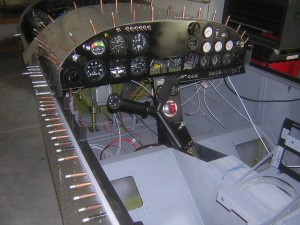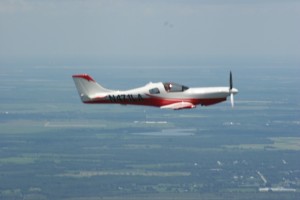By John Bernardo
Just as children derive self-satisfaction from building their own model ship, pilots gain a similar feeling when constructing their own amateur or “experimental” airplane. Many pilots are now handcrafting their own aircraft while working with a kit or just plans..
Today, as the cost of purchasing, maintaining and fueling a new certified aircraft continue to skyrocket, more pilots are now building their own airplanes. In addition to lowering ownership costs, a homemade plane allows the pilot to feel pride in a craft whose every bolt and nut they can call their own.
Paul Hershorin, of Lake Worth, Fla., recently built his own Lancair 360 aircraft (a high-performance plane).
“My plane is cool looking, and I loved building it. It was very fun and challenging,” Hershorin said. “Anybody can make his or her own plane; they just have to follow the manual like you would follow a cookbook. As long as the person is mechanically inclined, very detailed and takes pride in his or her workmanship, they can do it.”
Hershorin says the numbers of plane builders is increasing because pilots like flying a plane assembled with their own two hands.
“To sit down and build your own plane simply means pride in your own craftsmanship,” Hershorin said.
Rick Golightly of Jupiter has flied certified general aviation planes since he was 16. Today, he’s building his own plane, an Earlybird Jenny, from scratch (no kit—plans only).
“I started working on this plane about seven years ago; I should finish it in about two years,” he said. “It’s fun to build and I have a lot of pride in what I’m doing. I have a wonderful feeling knowing that I am building a plane of my own.”
“I trust the safety of this plane more, too, because I’m building it and getting it checked by certified mechanics during the process, he said. Golightly added that before a pilot builds any plane, it’s a good idea to read the manufacturer’s manual and inventory the parts before starting. This will save the builder trouble and money in the long run.
Golightly and Hershorin document (make log entries) and take photos of each step of their “home garage” aircraft assembly process; at a later date, those logs and pictures will be submitted to the Federal Aviation Administration during the airworthiness inspection.
Scott Thatcher, 66, of Palm Beach Gardens, has been flying for 53 years. He purchased and built an experimental aircraft about five years ago; the high cost of maintenance drove his decision. Thatcher built a Zenith 601XL plane, spending four years to complete the project in his garage.
Thatcher performed the final phase of assembly at the Experimental Aircraft Association hangar at North Palm Beach County General Aviation Airport (F45) in West Palm Beach, Fla. In December 2007, the FAA inspected and certified Thatcher’s 601XL as an Experimental Light Sport Aircraft.
“My last aircraft was a Mooney and it was 40 years old,” said Thatcher. “The repair costs to maintain a certified aircraft like a Mooney are no different than what it would be to maintain a new $400,000 Mooney; yet the repair and maintenance costs of building my own aircraft would be tremendously less money. I expect my yearly costs for the 601XL to be about $150, while the Mooney averaged $7,500.”
Not only do Hershorin, Golightly and Thatcher share the experience of building and flying their own planes, all are members of the EAA Club 203 in Palm Beach County. The club now consists of 35 active members; about 90 percent of them are pilots who’ve already built their own planes. The club also assists its members with the building process of their experimental airplanes.
“Experimental aircraft” is a term used by the FAA for aircraft flown for noncommercial, recreational purposes. Experimental aircraft can also include craft used for racing or exhibition, such as vintage military aircraft and planes used for research. If at least 51 percent of assembly occurs outside a factory, it’s considered an amateur-built aircraft.
A pilot and builder of an experimental plane who’s also a member of an EAA club can have the airplane inspected by an EAA inspector and veteran pilot two or three times before assembly is completed. If the EAA inspector finds any errors during construction, he can recommend appropriate adjustments to the aircraft. Although a pilot isn’t required to have his plane inspected by an EAA technician before finishing assembly, when it comes to flight safety, more pairs of eyes are better. Once assembly is completed, the plane can’t be flown until an FAA inspector certifies that the plane is airworthy.
Another advantage of being an EAA member is that it’s easier for member pilots with homebuilt planes to obtain aviation insurance.
Bill Perry, president of EAA Club 203 and a certified EAA inspector, said that when pilots build their own planes, it’s a learning process; they’re building planes used for recreational purposes only.
“The pros of constructing a light sport plane is that you get more airplane for your money, your maintenance costs are lower and you can build what you want to fly,” Perry said.
One possible disadvantage of an aviator constructing his own plane might be time invested—it can take years to finish assembly on a homebuilt aircraft.
“The normal time frame [for assembly] is from two to five years; but that depends upon the complexity of the plane and the dedication of the builder,” Perry said.
Safety isn’t an issue when flying a homebuilt airplane.
“Homebuilt planes are just as safe as or even safer than certified planes. About 90 percent of accidents are caused by pilot error, and that has nothing to do with the type of plane [experimental or certified].”
According to Perry and other members of EAA Club 203, about 90% of experimental planes are kit-built. Presently, the Van’s Aircraft RV-7 is the most common type of kit-built aircraft flown.
Aircraft powered by automobile engines are common for kit builders, Perry said.
“There have been Volkswagen, BMW, Chevy and other car motors put into these planes; even motorcycle engines are placed into these aircraft. These motors are just as safe as aircraft engines. You just have to find a person who knows what he’s doing when it comes to conversions, Perry said.
For more information about kit planes, visit [http://www.kitplanes.com]. In addition to airplanes, pilots can construct and fly their own sport helicopters; for more information, visit [http://www.vertical-aviation.com]. For more information about the RV-7, visit [http://www.vansaircraft.com”.














